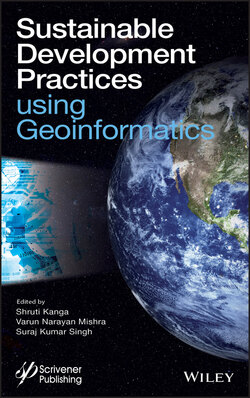Читать книгу Sustainable Development Practices Using Geoinformatics - Группа авторов - Страница 17
1.3.2 Methodology
ОглавлениеLandsat images of different time are very helpful for the analysis of land use and land cover change pattern and to measure the increase in urban built-up area (Song et al., 2001). To meet the objectives of the study, the following procedures were done. Pre-processing is an essential step for removing the atmospheric noise and haze, which is there in the image due to atmospheric scattering of solar radiation due to atmospheric elements (Chander, Markham, and Helder 2009). Satellite images were classified using Maximum Likelihood classification algorithm because it gives better accuracy than other available techniques like box classifier, minimum distance to mean, etc., available in published literature (Lyon et al., 1998; Reis 2008; Patidar and Sankhla 2015).
Figure 1.1 Location map of Barasat municipality.
Table 1.1 List of datasets used for the study.
| Satellite/Sensor | Date | Source |
|---|---|---|
| Landsat 5 (TM) | January, 2001 | USGS |
| Landsat 5 (TM) | January, 2011 | USGS |
| Landsat 8 (OLI and TIRS) | January, 2017 | USGS |
| MOD11A1 | January: 2001, 2011, 2017 | USGS |
| Census | 2011 | Census of India |
| Barasat municipality boundary | 2014 | Barasat municipality |
The study area was classified into six classes inclusive of built-up area, agricultural fallow, bare land, water body, green space, and built up with green space. The main aim was to measure the increase in built-up area, which is an indicator of urbanization. Further, accuracy of the classified images was calculated, and confusion matrix generated to highlight the user accuracy, producer accuracy, and Kappa statistics thus obtained (Foody 2002; Berberoglu and Akin 2009).
The urban growth is a process of urbanization, which always follows a pattern of development. In urban areas, the pattern differs from core to periphery region. In this study, two different types of pattern had been observed, one was concentric, and another one was linear. The concentric circular pattern was found in the areas of tri-junction of roads or in the “Y” point where the development is very rapid and shows multiplier effect of growth. The linear pattern of development was observed from 2001 to 2017 along the sides of roads and railway lines (Figure 1.2), which is very common in this region. Hence, both the developmental patterns are simultaneously affecting the environment of the area significantly.
Figure 1.2 Road and railways network in Barasat municipality.
NDVI is a very popular vegetation index used to measure the biomass content of vegetation with respect to its spatial entity (Volcani, Karnieli, and Svoray 2005). Two different bands, NIR and Red of remote sensing data, are used for calculating the NDVI (Bhandari, Kumar, and Singh 2012; Yin et al., 2012). The formula for NDVI (Eq. 1.1) calculation is as follows:
(1.1)
Remote sensing helps in deriving LST, which is used in various studies related to local climatology, meteorology, and climate change, etc., as the observations collected from the ground cannot provide much detailed information over a larger area (Wu et al., 2015). LST is the temperature radiated by the surface and measured within limited boundary of lower atmosphere from the surface, which is proportionally dependent on land surface emissivity (Wan and Dozier 1996; Wang et al., 2015; Isaya Ndossi and Avdan 2016). The LST is technically different from the Atmospheric temperature and is largely affected by the urban canopy layer. LST calculation was done with the help of Inversion of Planck’s Function (Isaya Ndossi and Avdan 2016; Zhang, Wang, and Li 2006; Srivastava et al., 2014; Artis and Carnahan 1982; Sobrino, Caselles, and Becker 1990). The formula for LST calculation (Eq. 1.2) is as follows:
(1.2)
where Ts = land surface temperature (°C), BT = brightness temperature (K), λ = wavelength of the emitted radiance, ρ = (h * c/σ) = 1.438 *10−2mK, and ε = land surface emissivity
